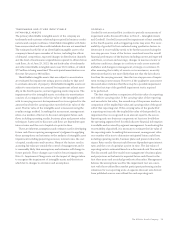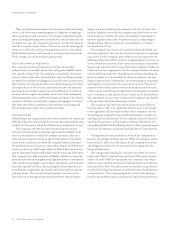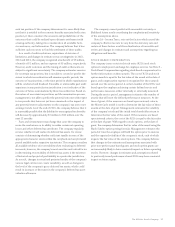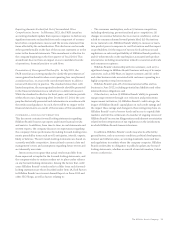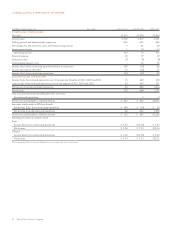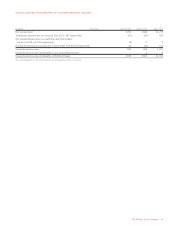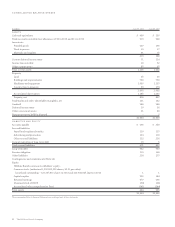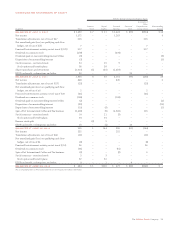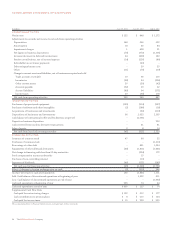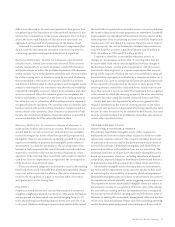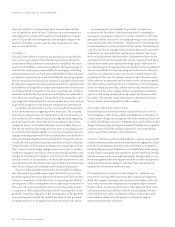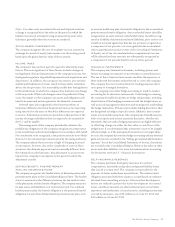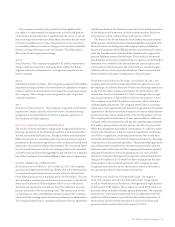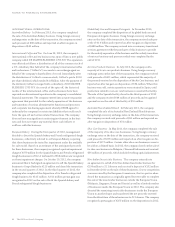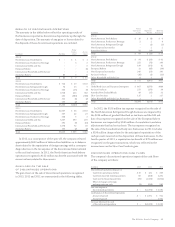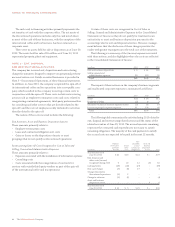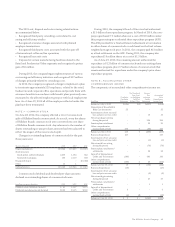Sara Lee 2013 Annual Report Download - page 37
Download and view the complete annual report
Please find page 37 of the 2013 Sara Lee annual report below. You can navigate through the pages in the report by either clicking on the pages listed below, or by using the keyword search tool below to find specific information within the annual report.The Hillshire Brands Company 35
NOTE 1 – NATURE OF OPERATIONS
AND BASIS OF PRESENTATION
NATURE OF OPERATIONS
The Hillshire Brands Company (corporation, company or Hillshire
Brands) is a U.S.-based company that primarily focuses on meat and
meat-centric food products. The company’s principal product lines
are branded packaged meat products and frozen bakery products. Sales
are made in both the retail channel, to supermarkets, warehouse
clubs and national chains, and the foodservice channel.
The relative importance of each of the company’s business segments
over the past three years, as measured by sales and operating segment
income, is presented in Note 19 – Business Segment Information,
of these financial statements.
BASIS OF PRESENTATION
The Consolidated Financial Statements include the accounts of the
company and all subsidiaries where we have a controlling financial
interest. The consolidated financial statements include the accounts
of a variable interest entity (VIE) for which the company is deemed
the primary beneficiary. The results of companies acquired or dis-
posed of during the year are included in the consolidated financial
statements from the effective date of acquisition, or up to the date
of disposal. All significant intercompany balances and transactions
have been eliminated in consolidation.
The fiscal year ends on the Saturday closest to June 30. Fiscal
2013, 2012 and 2011 were 52-week years. Unless otherwise stated,
references to years relate to fiscal years.
Discontinued Operations The Australian bakery business is reported
as discontinued operations beginning in 2013. The results of the
international coffee and tea, North American foodservice beverage,
European bakery, North American fresh bakery, North American
refrigerated dough, and international household and body care busi-
nesses had previously been reported as discontinued operations in
the company’s 2012 annual report. The results of operations of
these businesses through the date of disposition are presented as
discontinued operations in the Consolidated Statements of Income
for all periods presented. For business dispositions completed prior
to 2013, the assets and liabilities of discontinued operations, prior
to disposition, were aggregated and reported on separate lines of
the Consolidated Balance Sheets.
Financial Statement Corrections During 2013, the company
corrected certain balance sheet accounts as well as SG&A and
income tax expense in the income statement related to continu-
ing operations for errors that included the understatement of an
asset for deposits held as collateral by insurance companies and
the understatement of non-current deferred tax assets related to
an employee benefit plan. It also corrected certain errors related
to the tax provisions associated with the operating results for
discontinued operations and the gain/loss on sale of discontinued
operations. For the full year 2013, the correction of these errors
increased income for continuing operations by $9.5 million
pretax ($8.3 million after tax) and net income by $11.0 million.
The company evaluated these errors in relation to the period in
which they were corrected, as well as the periods in which they
originated, and concluded that these errors did not materially
misstate the 2013 financial statements or any previously issued
financial statements.
NOTE 2 – SUMMARY OF
SIGNIFICANT ACCOUNTING POLICIES
The Consolidated Financial Statements have been prepared
in accordance with generally accepted accounting principles in
the U.S. (GAAP).
The preparation of the Consolidated Financial Statements
in conformity with GAAP requires management to make use of
estimates and assumptions that affect the reported amount of
assets and liabilities, revenues and expenses and certain financial
statement disclosures. Significant estimates in these Consolidated
Financial Statements include allowances for doubtful accounts
receivable, net realizable value of inventories, sales incentives,
useful lives of property and identifiable intangible assets, the evalu-
ation of the recoverability of property, identifiable intangible assets
and goodwill, self-insurance reserves, income tax and valuation
reserves, the valuation of assets and liabilities acquired in business
combinations, assumptions used in the determination of the funded
status and annual expense of pension and postretirement employee
benefit plans, and the volatility, expected lives and forfeiture rates
for stock compensation instruments granted to employees. Actual
results could differ from these estimates.
REACQUIRED SHARES
The Company is incorporated in the State of Maryland and under
the laws of that state shares of its own stock that are acquired by
the Company constitute authorized but unissued shares. The cost of
the acquisition by the Company of shares of its own stock in excess
of the aggregate par value of the shares first reduces capital surplus,
to the extent available, with any residual cost applied against
retained earnings.
SALES RECOGNITION AND INCENTIVES
The company recognizes sales when they are realized or realizable
and earned. The company considers revenue realized or realizable
and earned when persuasive evidence of an arrangement exists,
delivery of products has occurred, the sales price charged is fixed or
determinable, and collectability is reasonably assured. For the com-
pany, this generally means that we recognize sales when title to and
risk of loss of our products pass to our resellers or other customers.
In particular, title usually transfers upon receipt of our product at
our customers’ locations, or upon shipment, as determined by the
specific sales terms of the transactions.
NOTES TO FINANCIAL STATEMENTS


